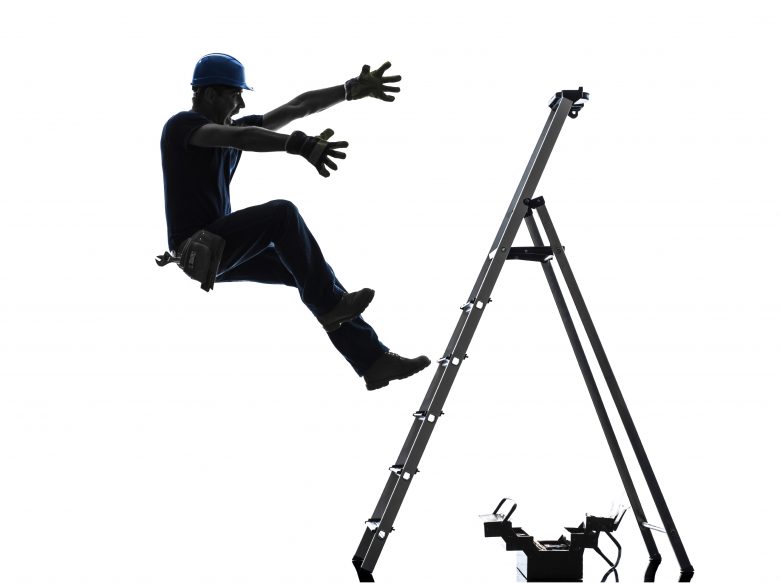A ladder might be a common tool, but just like any other piece of equipment, it needs to be used correctly to be safe—something that happens far less than it should.
If people used ladders correctly, there would be no need for awareness campaigns like National Ladder Safety Month. But every day 500 workers go to the emergency room after a ladder-related incident and some of those workers die due to the seriousness of their injuries. Ladders are also one of OSHA’s top ten violations year after year.
The misuse of ladders and related incidents are such a common problem that the Ladder Association, a UK organization promoting ladder safety, organizes a yearly Idiots on Ladders competition featuring a collection of photos.
Ladder safety begins by delivering adequate training (like the education provided by the American Ladder Institute) and following ladder safety regulations and best practices.
Ladders are only acceptable for work of short duration and should be erected at a correct angle, secured and positioned close to the work to avoid over-reaching. A great tip to remember when using ladders is the “belt buckle” rule: stay centered and don’t let your belt buckle go past either side rail. Ladders should also be protected at the base to prevent pedestrians or vehicles from bumping into them. When climbing to significant heights, a fixed ladder is advised.
Stepladders should always be spread to their full extent and locked, and the top platform should not be used as a step. Neither should the tool shelf or the rear part of the ladder. The ladder must be the correct type for the work and can only be used by one person at a time.
Here are some basic ladder safety rules:
- Only use ladders for their designed purpose
- Make sure you’re using the right type of ladder for the job
- Read the information on the label and double-check the ladder’s Duty Rating
- Inspect the ladder for any damage
- Rethink your plans if you’re dizzy or fatigued
- Make sure the climbing and gripping surfaces are clean and free of oil, grease, and other slip hazards
- Make sure that your shoes are clean of any substances which could cause you to slip
- Use the ladder at a correct angle and make sure it’s secured
- Make sure you use your ladder on firm and level surfaces
- Protect your ladder at the base to prevent people or objects from bumping into it
- Maintain three points of contact
- Do not carry objects that could cause loss of balance
Despite some of the safety rules being very simple—or maybe because of their simplicity—they get ignored. When a piece of equipment is very familiar and used every day, it’s easy to become complacent and misuse it. Every year, many experienced workers fall off ladders seriously injuring themselves or dying because they’ve become so comfortable with working at heights that they’ve forgotten how dangerous it is. Frequent reminder training for ladder safety is an effective way to curb the effects of complacency as is building strong ladder safety habits that can compensate for moments when complacency strikes.
The portability of ladders can give you a leg up just about anywhere, so ladder safety habits need to be carried everywhere too. Ladders are one of those pieces of equipment that are used at work and at home. Even though the same rules and risks apply both on and off the job, it can be easy to forego or forget workplace procedures when nobody is watching or the perception of risk changes in a more comfortable home environment.
The more frequently someone uses ladders at work, the more comfortable they’ll be at home. This makes it especially important to instill strong safety habits and help people understand the temptation they’ll face to take shortcuts, change their behavior or relax their attention to safety without the company culture and supervision that makes them think twice.
When using ladders at home, people are more likely to find reckless workarounds to work-impeding problems. If a ladder is too short, prop it up on something. No PPE handy? Use a hand to shield your eyes. These kinds of solutions would make a safety manager shudder and get employees into trouble, but at home, there is only the person’s knowledge, judgment, habits and internal culture of safety to guide them.
Employees who don’t use ladders at work may have never been trained or given even a basic understanding of ladder use. So consider providing your entire staff with some level of ladder knowledge regardless of whether it is a requirement of the job. If they fall from a ladder at home, it may not be your responsibility, but it can lead to a lost-time injury that will affect your company negatively in many ways.
Additionally, whether you’re talking ladder safety, PPE or DIY projects around the home, all types of workers would benefit from having a good understanding of how human factors like rushing, frustration, fatigue and complacency can lead them to make mistakes or not follow sound safety practices at home that could lead to serious, unexpected outcomes—and therefore how important it is to understand and follow rules even when nobody is watching.

